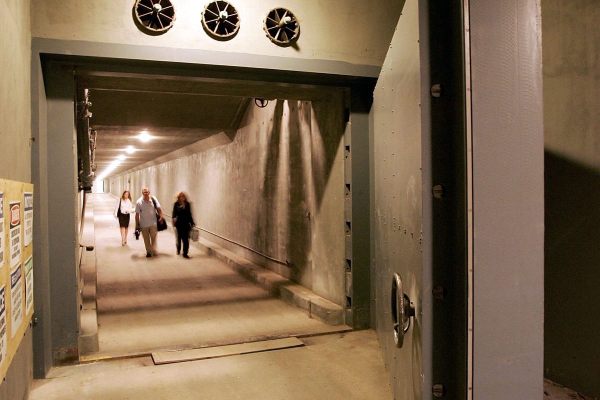Watch Five Alarmingly Calm Men Stand Under an Exploding Atomic Bomb
In 1957 a group of soldiers watched an atom bomb go off directly above their heads.
In 1945, the first atomic bomb was set off during the Trinity Test in the New Mexican desert. This marked the birth of the Atomic Age, a period of nuclear experimentation that would alter the world on a sociocultural level, not to mention an elemental one.
Today we know the danger of exposure to atomic bombs. First there is the initial fiery explosion, caused by the splitting of an atom. However, the arguably more dangerous effect of the atom bomb is its radiation, both from the original blast and the residual radioactivity left in its wake. This can spread over a miles-long diameter, but is most concentrated at ground zero, the point directly underneath the detonation. Hence why this video of five men standing directly beneath an atomic bomb test is a bit disturbing.
On July 19th, 1957, Col. Sidney Bruce, Lt. Col. Frank P. Ball, Maj. Norman “Bodie” Bodinger, Maj. John Hughes, and Don Luttrel all volunteered to stand beneath the bomb. As the video shows, they stand next to a sign, intended to be humorous, which reads: “GROUND ZERO Population 5”. The men are huddled together, their hands shading their eyes, wavering in anticipation as a radio voice counts down from 10.
At 0:55 we see the bomb released from the plane. At 0:59 a a burst of white light illuminates the volunteers’ faces. They wince at the brightness, though Major Bodinger, who thought to wear sunglasses, keeps his eyes trained at the sky the whole time. He is equipped with a microphone, and narrates the experience live. “We felt a heat pulse,” he says, “a very bright light, a fireball, it is red, the sky looks black about it, it is boiling above us there, it is wrapped in–”
At this point, about 10 seconds after the blast, the sound wave hits. The men, who had been looking at mushroom cloud above them, duck and cover, then stumble about. Major Bodinger’s voice swells in excitement while his companions can be heard shouting in the background. “There is the ground wave! It is over folks, it happened. The mounds are vibrating. It is tremendous, directly above our heads. It worked! It worked!”
The test was one of hundreds conducted by the U.S. military at this point in time, and the bomb detonated was relatively small—a mere two kilotons. The purpose of having the men stand at ground zero was simply to observe what the explosion was like from such a close perspective.
So what happened to them? It’s complicated. George Yoshitake, the cameraman who did not volunteer, reported that many of his fellow atomic cameramen had died of cancer, presumably as a result of exposure to radiation. Over the years the government has paid upwards of $150 million to onsite participants in atomic tests, not to mention those unwittingly exposed by being downwind of radioactive explosions. Reporters have attempted to find the men who took part in the 1957 test, but to no avail. Military records indicate they are all dead, but with no word on whether their fatality was linked to radioactive exposure.
It must have been exciting, if not a little terrifying, to take part in such a grand experiment, one that literally changes the elemental makeup of the world around you. Major Bodinger ends his transmission sounding moved: “This thing went off with a white flash. It was just beautiful.”
Every day we track down a Video Wonder: an audiovisual offering that delights, inspires, and entertains. Have you encountered a video we should feature? Email ella@atlasobscura.com
Update, 9/15: An earlier version of this story had the wrong date of the test—it is now correctly noted as 1957. We regret the error.


























Follow us on Twitter to get the latest on the world's hidden wonders.
Like us on Facebook to get the latest on the world's hidden wonders.
Follow us on Twitter Like us on Facebook